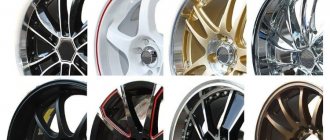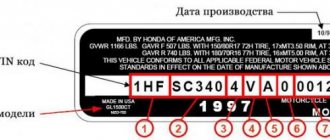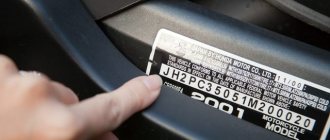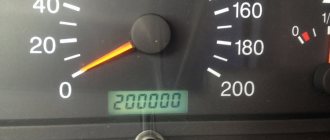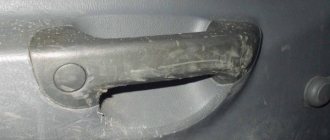Buying a used car always carries a certain risk of purchasing equipment that does not meet its specifications. A thrifty owner, on the eve of selling his old car, will carry out pre-sale preparation, clean it, tint it, change the oil, and adjust the engine. All this is good and benefits both parties to the transaction - the seller will sell at a higher price, and the buyer will not spend money on cosmetic repairs and eliminating minor defects.
However, there are also negative aspects to such preparation. In Russia, many companies involved in pre-sale preparation officially offer such a service as writing off the odometer readings, the car's mileage meter, which keeps track of the engine's operating hours from the moment it leaves the factory assembly line. This basically illegal activity has led to the fact that now you can no longer trust what the meter shows on the dashboard, and you need to know how to determine the mileage of a car in other ways.
Why do they twist the mileage?
Most often, the odometer readings are changed in order to sell the car at a higher price. However, there are a number of other reasons why sellers resort to this procedure. Twisting of readings may be caused by the need to:
- avoid expensive maintenance (the on-board computer of some foreign cars contains information about the time of maintenance; if this schedule is violated, it begins to issue alarm messages);
- hide the fact of replacing the dashboard (after an accident or for other reasons);
- keep silent about malfunctions of components that may affect the correct operation of the speedometer (for example, generator, battery, etc.).
You may be faced with the fact that the mileage of used cars imported into Russia from those countries where the amount of transport tax is calculated depending on the kilometers traveled by the car over a certain period of time is increased. https://montage-advertising.moscow
For example, such a system has been in operation for several years in the Netherlands, where a car’s mileage is tracked using GPS. In some US states, car owners have to pay $0.012 per mile.
By the way, under American law, mileage abuse is a criminal offense. Serious liability for such actions is provided for in Germany and France (up to 1 year and up to 2 years of imprisonment, respectively). Russian legislation does not provide for punishment for mileage inaccuracy.
Ways to twist mileage
Fraudsters have several techniques in their arsenal to deceive gullible customers. The choice of one method or another primarily depends on the type of device installed on the machine, which is responsible for calculating the distance traveled.
Here it is necessary to clarify and talk about the fact that many inexperienced car owners mistakenly associate the increase in mileage with adjusting the speedometer readings. In fact, it shows the speed of movement, and the number of kilometers traveled by the vehicle is recorded by another device - odometer .
The device works in close connection with the speedometer. And the panels that display the readings of these two devices are usually located next to each other. Apparently this is where some confusion in concepts arose. In order not to confuse the reader even more, we agree that the use of both definitions is acceptable.
A car can be equipped with one of three types of odometers:
- mechanical;
- electromechanical;
- electronic.
Mechanical and electromechanical devices were used in the automotive industry until the end of the last century. They are distinguished by a rather primitive device: the speed of the gearbox gearbox is transmitted through a special cable to a meter, the readings of which are displayed on the dashboard. It is easiest to check the mileage of such a device.
Method number 1. The odometer is disassembled, and the necessary readings are set on the meter manually.
Method number 2. To implement it, you will need to disassemble the dashboard and attach any power tool with high rotation speed (screwdriver, drill, etc.) to the speedometer cable using a special attachment. After this, the readings are twisted to the desired value. Of course, this can be done manually, but using a power tool speeds up the process many times over.
For an electromechanical odometer, twisting is carried out in a similar way. The only difference is that if, when taking readings from a mechanical device, the on-board power of the car is turned off (the terminals from the battery are removed), then when carrying out manipulations with an electromechanical device, the power cannot be turned off (otherwise the meter wheels will not rotate). Therefore, there is a high probability of a short circuit occurring.
The cost of the work is quite affordable and ranges from 1 to 1.5 thousand rubles. It’s quite easy to find advertisements in newspapers or on the Internet for companies willing to provide such a service. They are usually hidden under signs like this: “Speedometer adjustment and repair.”
Also on the topic: All about evacuation to the impound lot in questions and answers
Quite a few home-grown “Kulibins” in their own garages make a living by turning mileage. Usually people find out about them through word of mouth.
From an official dealer
If it is possible to take the car to an official dealer, then they will check the mileage for the car originally purchased in Russia without any problems, and they will also tell you about maintenance.
POPULAR WITH READERS: How to make an antifreeze with your own hands
It is worth considering that if in old cars the mileage was recorded only on the dashboard, then in modern cars the mileage is constantly duplicated, and a cheap correction will not hide this.
If the car arrived from the USA, then the mileage can be determined through the CarFax and AutoCheck programs.
Rolling up the electronic odometer
The operation of devices of this type is based on reading the readings of special sensors (they can be optical or magnetic), which are installed on the gearbox shaft or directly on the vehicle wheel. The readings go into the on-board computer, which records them and transmits them to the electronic display.
On expensive car models (Toyota, Audi, etc.), mileage data can be stored in several memory blocks at once. According to experts, it is most difficult to change the mileage traveled on a BMW (the car can have up to 10 backup storage points). However, experts unanimously claim that if you have the appropriate equipment, you can check the mileage of absolutely any vehicle.
Several tricks are used to manipulate electronic odometers.
Method number 1. Designed for fraud with budget cars. To implement it, it is enough to remove the dashboard and connect the car’s on-board computer to a laptop on which the appropriate software is installed, or to a special device - a programmer. After this, the actual readings change.
Method number 2. Used for fraud with expensive cars that have several backup data storage units. In its principle it is almost identical to the first. However, it is very important for the fraudster to detect all information storages, otherwise during further operation the car computer can restore data from the backup storage, then the real mileage will again be displayed on the display.
The cost of the service depends on the complexity of the work and can vary from 2.5 to 10-12 thousand rubles.
Determining the true kilometers of a used car
The car's mileage is calculated on the instrument panel. Drivers are accustomed to determining the number of kilometers or miles using the odometer. An odometer is a device that converts the rotation of a wheel into a reading on a scale. Devices are divided according to the sensor design:
- Mechanical . They were used in the initial versions of the car and have a drum indicator.
- Electronic . Pulses are read from the sensor and supplied to the electronic control unit. There it is transformed into a form convenient for perception. The screen displays miles, kilometers, meters.
- Electromechanical . They are a design with a mechanical and electronic sensor. The electronic converts the mechanical readings and transmits the signal to the display installed on the driver’s panel.
When buying a used car, the mileage on the panel does not always correspond to the real one. The reasons are:
- malfunction of the measuring system;
- lack of device;
- fraud (rewinding odometer readings).
In such situations, the question arises: “How to determine the real mileage of a car?” Below are indirect signs that determine the age and mileage of a car.
How to check if the speedometer on a car is twisted
In order not to overpay for a supposedly “almost new car,” you need to remember how you can find out about the fact of fraud.
Unfortunately, there is currently no technical means of checking whether the mileage has been adjusted or not on a vehicle with a mechanical or electromechanical odometer.
Here you will have to be guided by the data of the external examination. The fact that the speedometer is twisted can be determined by the presence of traces of removing the instrument panel, the degree of wear of tires, brake discs, etc.
Also read: How to check car mileage
Using Autocode, Autotek and other services
You can find out the history of the car you are selling right before the transaction; all you need is a mobile phone. By logging into the Autocode service, enter the car’s registration number into the frame, and you will receive free data on the year of production of the vehicle, its category, engine size and power.
To get a more complete report, you need to pay about 350 rubles, a package of 5 reports costs about 1270 rubles. At Autotek one report costs 129 rubles. This is not such a lot of money compared to how much it is quite possible to overpay to a cunning seller. You will learn literally everything about the car you are selling: whether it was used as a taxi - and such a car should not be bought under any circumstances - what is the actual mileage, whether the car was involved in accidents, technical inspection data, the status of the owner, what fines he paid and even customs history.
In a word, you can find out the real mileage of a car using different methods. Use the professional advice of the site avtoinstruktor199.ru, be careful - and then the purchase will only be a joy!
How to find out if the mileage on a car with an electronic odometer is wrong
To establish the fact of fraud, you will need to conduct computer diagnostics. If you have the appropriate software, equipment and knowledge, you can check the car for twisted mileage yourself. But it is better to contact a trustworthy service center.
The ideas of many car enthusiasts about the wonders of computer diagnostics are too exaggerated. Those who think that there is a special item in the memory of the on-board computer, by looking into which you can check the real mileage, are mistaken. Most often, you can find out about the fact of interference in the electronic filling of a vehicle only by indirect signs.
Usually this is a discrepancy in data, for example, about the time of an event recorded by the on-board computer. For example, if during a check the car’s odometer shows 75 thousand km, and the memory contains information about an error recorded after 150 thousand km. Or the owner swears that his “iron horse” has run no more than 50 thousand km, but when dividing the kilometers traveled by the number of engine hours, the average speed of movement is 4-5 km/h.
The more such oddities revealed by checking the car’s speedometer, the more reason the buyer has to wonder whether he needs such a “dark horse”.
Self-determination
There are several signs of a car that can make you suspect the seller of inflating the mileage:
- Severely worn pedals. If the driver claims that the car has traveled less than 100 thousand kilometers, and the metal pedals have severe scuffs, then we can confidently speak about deception. If the rubber pad is perfectly flat, then this should also be a concern, because it could simply be replaced.
- Shabby upholstery. A large number of scuffs and dirt may indicate heavy use of the vehicle.
- Worn seat upholstery. If the car has traveled a long distance, then the seats will be worn, faded, dented: the driver's seat - probably, the passenger seat - if the car was used in taxi mode.
Also on the topic: Where can and where can’t you legally wash your car?
If you have any suspicions regarding the indicated mileage, suggest that the seller go to an independent expert who can confirm or refute the suspicions. Or you can use special Internet services that allow you to check the actual mileage of a car using the VIN code.
According to the condition of the car interior
Yes, don’t be surprised, many people don’t pay any attention to the condition of its interior when determining the real mileage of a car, but in vain.
Pedals.
How to determine the mileage of a car based on the condition of the pedals?
Very simply, heavily worn rubber pads on the pedals, as well as metal pads polished by the soles, indicate that the car’s mileage is more than 100 thousand km. Brand new rubber bands should also be a concern.
Carpet.
The carpet is the dirtiest place in a car and is in constant contact with shoes. Carefully inspect it everywhere, even in hard-to-reach places.
Your task is to find scuffs and stains that will tell you the approximate age of the car, because replacing the entire carpet is too tedious and expensive.
Minor abrasions are typical for mileage of 50-100 thousand km. If the mileage is more than 200 thousand km. the coating will not be new at all.
Thus, if the interior of the car is neglected, then it is better to refuse; either the mileage is two or three times higher than indicated, or the car has simply not been taken care of, which is really worse.
Steering wheel.
You can determine the actual mileage of a car by looking at the steering wheel. If it was originally made of leather, then the owner is unlikely to alter it or exchange it for a new one.
Pay attention to the condition of the drawings of the steering wheel buttons (if any), threads and the surface itself. With a mileage of up to 100 thousand, there should be no severe abrasions.
Driver's seat.
The condition of the surface of the driver's seat should realistically correspond to the abrasions of the surface of the steering wheel and the interior as a whole.
A noticeable scatter is a reason for additional questions. In practice, it has been observed that the fabric interior noticeably wears out and burns out after 100 thousand km.
To compare how different the fabric is from new in condition and color, just look at the front part of the seats and the part that is “far from the eyes” (for example, on the sides).
You can evaluate the leather interior in the same way, up to 100 thousand km. The paint and varnish come off from it, and closer to 200 thousand km. holes appear.
You can determine the condition of the seats by comparing the side supports of the seats. The more worn out the left cushion is compared to the right one, the older the car is.
We also pay attention to the condition of the seams and the color of the threads. If the car is old and the interior has been tinted, then this can be determined by stretching the surface of the seat “to the point of breaking.”
Door handles, gearboxes, buttons.
Another good way to find out the mileage of a car. Even when the car is used carefully, the driver and passenger touch the door handles and window lift buttons.
Their condition will tell you about the actual mileage of the car. Despite the fact that these are not expensive parts, they are usually not replaced with new ones.
If the car has a manual transmission, then abrasions on the gearshift knob will indicate the age of the car. Also pay attention to the gearshift knob and parking brake cover; if the mileage is low, there should be no cracks or other signs of wear on it.
Advantages of checking by VIN code
The VIN code is a unique set of 17 digits that allows you to identify a specific vehicle. It is in the VIN code that the key characteristics of the car, information about the manufacturer and other data are encrypted.
Checking a car's mileage using the VIN code is a great way to make sure that the owner has not changed the meter readings before selling a used car. After each database update, information about the number of kilometers traveled is entered here. It is impossible to change such information, because the VIN number of a car cannot be falsified unnoticed.
Thus, checking a car for actual mileage using VIN or state registration number. number - a mandatory procedure before purchasing it. If you neglect such a check, you can get a vehicle that is not worth the money spent, will require significant investments for repairs, and will become a source of unnecessary hassle instead of being a means of transportation.
